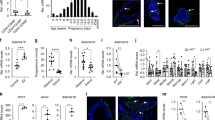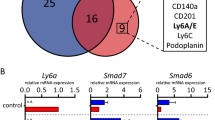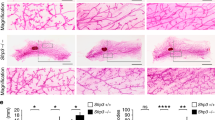Abstract
Mice with a null mutation in the cell surface heparan sulfate (HS) proteoglycan, syndecan-1 (Sdc1), develop almost normally, but resist mammary tumor development in response to Wnt-1. Here, we test the hypothesis that Sdc1 promotes Wnt-1-induced tumor development by interacting with the Wnt cell surface signaling complex. Thus, the response of Sdc1−/− mammary epithelial cells (mecs) to the intracellular, activated Wnt signal transducer, ΔNβ-catenin, was assayed both in vitro and in vivo, to test whether β-catenin/TCF transactivation was Sdc1-independent. Surprisingly, we found that the expression of a canonical Wnt pathway reporter, TOP-FLASH, was reduced by 50% in both unstimulated Sdc1−/− mecs and in stimulated cells responding to Wnt1 or ΔNβ-catenin. Tumor development in response to ΔNβ-catenin was also significantly delayed on a Sdc1−/− background. Furthermore, the average β-catenin/TCF transactivation per cell was normal in Sdc1−/− mec cultures, but the number of responsive cells was reduced by 50%. Sdc1−/− mecs show compensatory changes that maintain the number of HS chains, hence these experiments cannot test the coreceptor activity of HS for Wnt signaling. We propose that TCF-dependent transactivational activity is suppressed in 50% of cells in Sdc1−/− glands, and conclude that the major effect of Sdc1 does not map to the activity of the Wnt signaling complex, but to another pathway to create or stabilize the β-catenin/TCF-responsive tumor precursor cells in mouse mammary gland.
This is a preview of subscription content, access via your institution
Access options
Subscribe to this journal
Receive 50 print issues and online access
$259.00 per year
only $5.18 per issue
Buy this article
- Purchase on Springer Link
- Instant access to full article PDF
Prices may be subject to local taxes which are calculated during checkout







Similar content being viewed by others
Abbreviations
- HS:
-
heparan sulfate
- HSPG:
-
heparan sulfate proteoglycan
- Sdc1:
-
syndecan-1
- wg:
-
wingless
- Fz:
-
frizzled receptor
- mecs:
-
mammary epithelial cells
- ΔNβcat:
-
[ΔN89]-β-catenin
References
Alexander CM, Reichsman F, Hinkes MT, Lincecum J, Becker KA, Cumberledge S and Bernfield M . (2000). Nat. Genet., 25, 329–332.
Baeg G-H, Lin X, Khare N, Baumgartner S and Perrimon N . (2001). Development, 128, 87–94.
Baeg G-H and Perrimon N . (2000). Curr. Opin. Cell Biol., 12, 575–580.
Bafico A, Liu G, Yaniv A, Gazit A and Aaronson SA . (2001). Nature Cell Biology, 3, 683–686.
Behrens J . (2000). J. Cell Sci., 113, 911–919.
Bernfield M, Gotte M, Park PW, Reizes O, Fitzgerald ML, Lincecum J and Zako M . (1999). Annu. Rev. Biochem., 68, 729–777.
Bienz M and Clevers H . (2000). Cell, 103, 311–320.
Bradley RS and Brown AMC . (1990). EMBO J., 9, 1569–1575.
Bradley RS and Brown AM . (1995). Mol. Cell. Biol., 15, 4616–4622.
Brantjes H, Barker N, Van Es J and Clevers H . (2002). Biol. Chem., 383, 255–261.
Burrus LW and McMahon AP . (1995). Exp. Cell Res., 220, 363–373.
Chan S-K and Struhl G . (2002). Cell, 111, 265–280.
Clevers H . (2000). Nat. Genet., 24, 206–208.
Cumberledge S and Reichsman F . (1997). Trends Genet., 13, 421–423.
Emerman JT and Bissell MJ . (1988). Adv. Cell Culture, 6, 137–159.
Hovanes K, Li TWH, Munguia JE, Truong T, Milovanovic T, Marsh JL, Holcombe RF and Waterman ML . (2001). Nat. Genet., 28, 53–57.
Imbert A, Eelkema R, Jordan S, Feiner H and Cowin P . (2001). J. Cell Biol., 153, 555–568.
Ishitani T, Ninomiya-Tsuji J, Nagai S-I, Nishita M, Meneghini M, Barker N, Waterman M, Bowerman B, Clevers H, Shibuya H and Matsumoto K . (1999). Nature, 399, 798–802.
Ishitani T, Ninomiya-Tsuji J and Matsumoto K . (2003). Mol. Cell. Biol., 23, 1379–1389.
Letamendia A, Labbe E and Attisano L . (2001). J. Bone Joint Surg. (Amer.), 83-A, S31–39.
Lin X, Buff EM, Perrimon N and Michelson AM . (1999). Development, 126, 3715–3723.
Lin X and Perrimon N . (1999). Nature, 400, 281–284.
Lustig B, Jerchow B, Sachs M, Weiler S, Peitsch T, Karsten U, van de Wetering M, Clevers H, Schlag PM, Birchmeier W and Behrens J . (2002). Mol. Cell. Biol., 22, 1184–1193.
Mao B, Wu W, Li Y, Hoppe D, Stannek P, Glinka A and Niehrs C . (2001). Nature, 411, 321–325.
Michaelson JS and Leder P . (2001). Oncogene, 20, 5093–5099.
Miller JR, Hocking AM, Brown JD and Moon RT . (1999). Oncogene, 18, 7860–7872.
Nishita M, Hashimoto MK, Ogata S, Laurent MN, Ueno N, Shibuya H and Cho KW . (2000). Nature, 403, 781–785.
Ornitz DM . (2000). Bioessays, 22, 108–112.
Payre F, Vincent A and Carreno S . (1999). Nature, 400, 271–275.
Perrimon N and Bernfield M . (2000). Nature, 404, 725–728.
Polakis P . (2000). Genes Dev., 14, 1837–1851.
Rasmussen SB, Young LJT, and Smith GH . (2000). Methods in Mammary Gland Biology and Breast Cancer Research, Ip MM and Asch BB (eds). Kluwer Academic/Plenum: New York.
Reichsman F, Smith L and Cumberledge S . (1996). J. Cell Biol., 135, 819–827.
Roose J, Huls G, van Beest M, Moerer P, van der Horn K, Goldschmeding R, Logtenberg T and Clevers H . (1999). Science, 285, 1923–1926.
Shimizu H, Julius MA, Giarre M, Zheng Z, Brown AM and Kitajewski J . (1997). Cell Growth Differ., 8, 1349–1358.
Stepp MA, Gibson HE, Gala PH, Iglesia DDS, Pajoohesh-Ganji A, Pal-Ghosh S, Brown M, Aquino C, Schwartz AM, Goldberger O, Hinkes MT and Bernfield M . (2002). J. Cell Sci., 115, 4517–4531.
Tsuda M, Kamimura K, Nakato H, Archer M, Starn W, Fox B, Humphrey M, Olson S, Futch T, Kaluza V, Siegfried E, Staatz and Selleck SB . (1999). Nature, 400, 276–280.
van de Wetering M, Sancho E, Verweij C, de Lau W, Oving I, Hurlstone A, van der Horn K, Batlle E, Coudreuse D, Haramis AP, Tjon-Pon-Fong M, Moerer P, van den Born M, Soete G, Pals S, Eilers M, Medema R and Clevers H . (2002). Cell, 111, 241–250.
Acknowledgements
Thanks to Ann Wozniak for determination of genotypes of transgenic mice. Thanks to Kathy Schell, Pamela Whitney and Joan Batchelder at the University of Wisconsin Flow Cytometry for their expertise and hard work. Thanks also to Sarah Millar for giving us a dkk1 clone before publication. This work is supported by NIH Grant CA 90877-01, a grant from the American Cancer Society (IRG-58-011-43-01), the University of Wisconsin Cancer Center Support Grant (P30 CA14520), a training award for BL (T32 CA09135) and an award from the Howard Hughes Medical Institute Research Resources Program for Medical Schools.
Author information
Authors and Affiliations
Corresponding author
Rights and permissions
About this article
Cite this article
Liu, B., Kim, Y., Leatherberry, V. et al. Mammary gland development requires syndecan-1 to create a β-catenin/TCF-responsive mammary epithelial subpopulation. Oncogene 22, 9243–9253 (2003). https://doi.org/10.1038/sj.onc.1207217
Received:
Revised:
Accepted:
Published:
Issue Date:
DOI: https://doi.org/10.1038/sj.onc.1207217
Keywords
This article is cited by
-
Physiological and anatomical aspects of the reproduction of mice with reduced Syndecan-1 expression
Reproductive Biology and Endocrinology (2019)
-
Prognostic significance of RSPO1, WNT1, P16, WT1, and SDC1 expressions in invasive ductal carcinoma of the breast
World Journal of Surgical Oncology (2013)
-
Syndecans in cartilage breakdown and synovial inflammation
Nature Reviews Rheumatology (2013)
-
Key signaling nodes in mammary gland development and cancer: β-catenin
Breast Cancer Research (2010)
-
Links between transforming growth factor-β and canonical Wnt signaling yield new insights into breast cancer susceptibility, suppression and tumor heterogeneity
Breast Cancer Research (2009)



